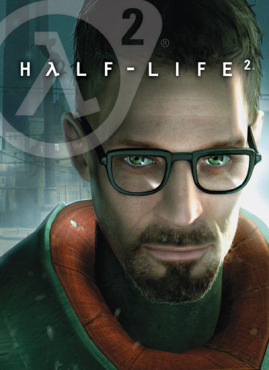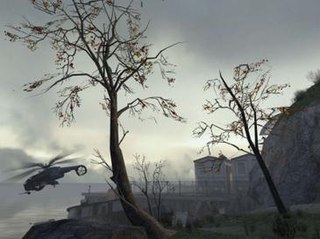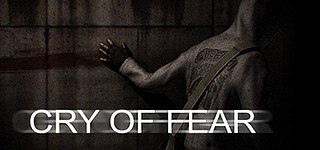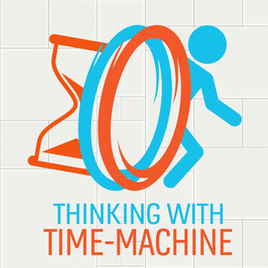Video game modding is the process of alteration by players or fans of one or more aspects of a video game, such as how it looks or behaves, and is a sub-discipline of general modding. Mods may range from small changes and tweaks to complete overhauls, and can extend the replay value and interest of the game.

Half-Life 2 is a 2004 first-person shooter (FPS) game developed by Valve. It was first published by Valve for Windows through its distribution service Steam. Like the original Half-Life (1998), Half-Life 2 combines shooting, puzzles, and storytelling, and adds features such as vehicles and physics-based gameplay. Players control Gordon Freeman as he joins a resistance movement to liberate the Earth from the control of an alien empire, the Combine.
Firearms is a first-person shooter mod for Half-Life which originated from a Quake modification. Initially developed in 1998, Firearms was created as a quasi-realistic team-based FPS. The mod's main feature is the large amount of usable weapons in the game.

Gunman Chronicles or Half-Life: Gunman is a first-person shooter space Western video game originally created as a mod by the now defunct Rewolf Software. Gunman Chronicles was originally a Quake deathmatch mod named Gunmanship 101, then it was moved to Quake II's engine before becoming a Half-Life mod. The game was popular at the Half-Life Mod Expo in 1999, and Sierra approached Rewolf to make a retail version. After significant work, Rewolf was given some office space, funding and a mapper by Valve Software to help complete the project and was released as a standalone game. Plans were drawn to release Gunman Chronicles on GameCube, but it was never released.

Dystopia is a team-based, objective-driven, first-person shooter video game, developed as a total conversion modification on the Valve's proprietary Source engine. It is based on the cyberpunk literary and aesthetic genre; it is somewhat based on popular role-playing game Shadowrun, created by an amateur development team and released to the public for free. Its first playable build was released on September 9, 2005, after a year of planning and nine months of development. The first full version of Dystopia, Version 1, was released after 3 years of development on February 25, 2007.

Concerned: The Half-Life and Death of Gordon Frohman is a webcomic by Christopher C. Livingston that parodies the first-person shooter video game Half-Life 2. The comic is illustrated with screenshots of characters posed using Garry's Mod, a tool which allows manipulation of the Source engine used by Half-Life 2. The comic ran from May 2005 to November 2006 and had 205 issues.

Minerva is an episodic series of single-player modifications ("mods") for Valve's Half-Life 2. The mod was created by Adam Foster. Installments are released as each is finalized: the three releases for the Metastasis chapter have already been made, with the third installment released on October 1, 2007.

Half-Life 2: Episode Two is a 2007 first-person shooter game developed and published by Valve. Following Episode One (2006), it is the second of two shorter episodic games that continue the story of Half-Life 2 (2004). Players control Gordon Freeman, who travels through the mountains surrounding City 17 to a resistance base with his ally Alyx Vance. Like previous games in the series, Episode Two combines shooting, puzzle-solving and narrative elements, but adds expansive environments and less linear sequences.

Half-Life is a series of first-person shooter (FPS) games developed and published by Valve. The games combine shooting combat, puzzles and storytelling.

A gravity gun is a type of device in video games, particularly first-person shooters using physics engines, whereby players can directly manipulate objects in the world, often allowing them to be used as projectiles against hostile characters. The concept was popularized by the gravity gun found in Valve's Half-Life 2, as well as the Temporal Uplink found in Free Radical Design's TimeSplitters: Future Perfect; although a similar concept was used by id Software during the production of the earlier game Doom 3, eventually leading to the introduction of a physics-based weapon in the expansion pack Resurrection of Evil. Later games, such as Portal, BioShock, Crysis, Dead Space, and Garry's Mod have been influenced by the success of these physics-based weapons, adopting their own styles of comparable abilities or weapons.

ModNation Racers is a 2010 go-kart racing video game developed by United Front Games and San Diego Studio for the PlayStation 3 and PlayStation Portable. User generated content is a central aspect of the game, such that it uses the same "Play, Create, Share" adage as LittleBigPlanet to convey its basis in online user-generated content sharing and level creation tools.

Black Mesa is a 2020 first-person shooter game developed and published by Crowbar Collective. It is a third-party remake of Half-Life (1998) made in the Source game engine. Originally published as a free mod in September 2012, Black Mesa was approved for commercial release by Valve, the developers of Half-Life. The first commercial version was published as an early-access release in May 2015, followed by a full release in March 2020 for Linux and Windows.
The Chinese Room is a British video game developer based in Brighton that is best known for exploration games, such as Dear Esther. The company originated as a mod team for Half-Life 2, based at the University of Portsmouth in 2007, and is named after John Searle's Chinese room thought experiment. In August 2018, it became a subsidiary of Sumo Digital.

The Stanley Parable is a story-based video game designed and written by developers Davey Wreden and William Pugh. The game carries themes such as choice in video games, the relationship between a game creator and player, and predestination/fate.

Cry of Fear is a survival horror game developed by independent Swedish studio Team Psykskallar. Though originally a mod for the video game Half-Life in 2012, it was released as a standalone product the following year.

Thinking with Time Machine is a single-player mod for Portal 2 developed by Stridemann, and released by SignHead Studio. It was initially released to Steam in April 2014, for Microsoft Windows, and OS X systems, available freely to existing owners of Portal 2.

Half-Life: Alyx is a 2020 virtual reality (VR) first-person shooter game developed and published by Valve. It was released for Windows and Linux with support for most PC-compatible VR headsets. Set five years before Half-Life 2 (2004), players control Alyx Vance on a mission to seize a superweapon belonging to the alien Combine. Like previous Half-Life games, Alyx incorporates combat, puzzles, exploration and survival horror. Players use VR to interact with the environment and fight enemies, using "gravity gloves" to snatch objects from a distance, similarly to the gravity gun from Half-Life 2.

Boneworks is a 2019 first-person shooter VR game developed and published by Stress Level Zero. The game is designed to be entirely physics-based, with the player controlling a full virtual body that responds not just to the player's real-world input but also to obstructions in the game world.















